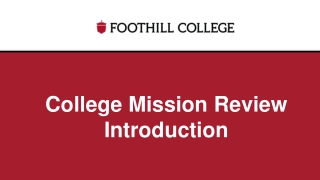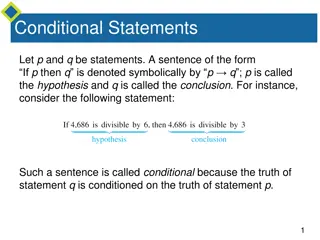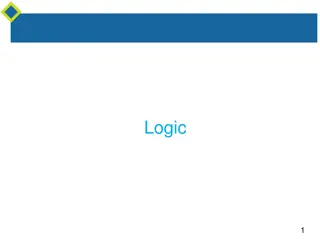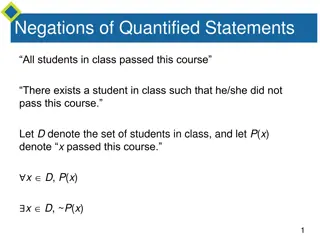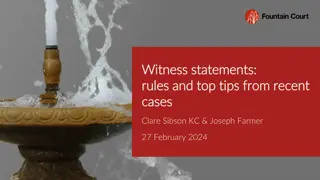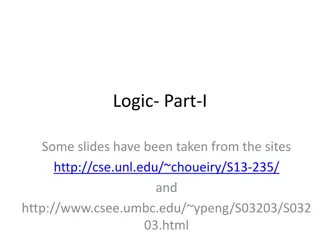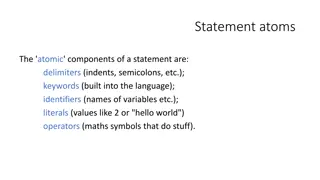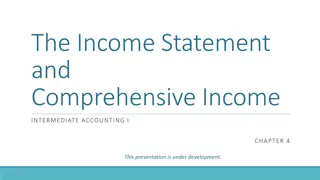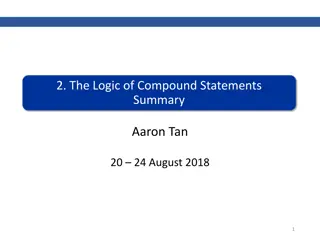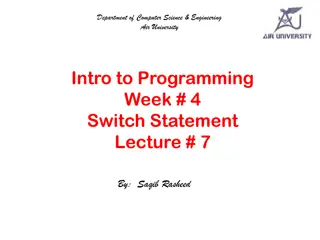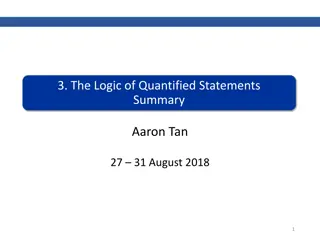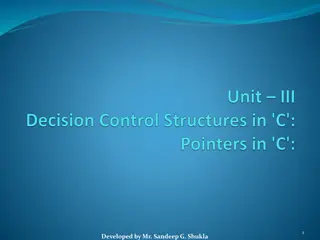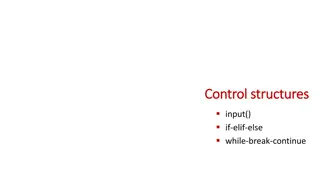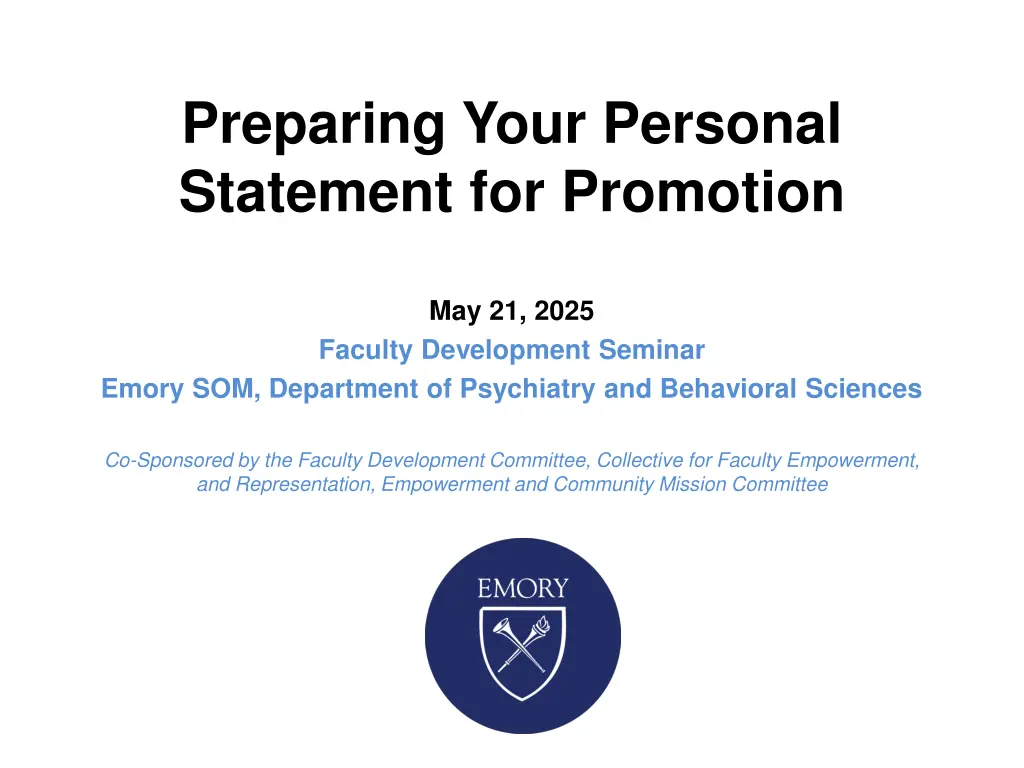
Craft Your Compelling Personal Statement for Academic Promotion
Learn how to effectively showcase your professional journey and highlight your achievements in your personal statement for academic promotion. Gain insights on the purpose, format, and importance of making it engaging yet authentic.
Download Presentation

Please find below an Image/Link to download the presentation.
The content on the website is provided AS IS for your information and personal use only. It may not be sold, licensed, or shared on other websites without obtaining consent from the author. If you encounter any issues during the download, it is possible that the publisher has removed the file from their server.
You are allowed to download the files provided on this website for personal or commercial use, subject to the condition that they are used lawfully. All files are the property of their respective owners.
The content on the website is provided AS IS for your information and personal use only. It may not be sold, licensed, or shared on other websites without obtaining consent from the author.
E N D
Presentation Transcript
Preparing Your Personal Statement for Promotion May 21, 2025 Faculty Development Seminar Emory SOM, Department of Psychiatry and Behavioral Sciences Co-Sponsored by the Faculty Development Committee, Collective for Faculty Empowerment, and Representation, Empowerment and Community Mission Committee
Overview Personal Statement Process Nadine Kaslow & Andrew Furman Examples provided by Jordan Cattie, Vinny Costa, Negar Fani, Rachel Hershenberg, Jennifer Holton, Allison LoPilato Small Group Discussion
What is the purpose of the Personal Statement? The purpose of the personal statement is to Share your story in an organized and compelling way Emphasize what you think is important Address issues that could be of concern This is a very important as people want to see the packet through the eyes of the candidate
How is it different from other materials? Whereas other materials follow a specific format, the Personal Statement allows people more liberty in format, structure, and content - it gives you the chance to be more authentic but no need to be a literary exercise The Personal Statement is a place where you can share your passion for your work and the more personal aspects of your career trajectory It offers you the chance to craft a narrative that integrates your personal and professional stories and paints a picture of who you are as a person and a professional
How important is it to make it interesting? While it doesn t need to be interesting , this is really your opportunity to engage the reader If you find your own professional story interesting, then convey that and others will find it interesting too
How personal is too personal? 1stparagraph Opportunity to share why things are meaningful and important to you This is not a therapy session, but definitely use this as an opportunity to convey who you are, your background, and the experiences that have made you who you are
Jordan Cattie 1stparagraph Growing up in a construction family outside of Philadelphia, the emphasis was on hard work and doing what was practical. Emotions were not discussed; education referred to night school. It remains a mystery to everyone how even as a young child, I approached life in a way that was exuberant and emotion- centric, interpersonally connected, and oriented toward holistic health and voracious learning. Despite our differences, the lessons from my childhood still guide me: Everybody matters; treat all people with kindness and respect. Bring your very best to your work and to those around you. Always leave things better than you found them. My CV reflects professional achievements fueled by these values: a desire to be of generous service, apply my persistence and knowledge to help others, and pursue equity and justice.
Vinny Costa 1stparagraph For more than 50 years, psychologists and neuroscientists have known that similar affective gradients of appetite and defense sculpt the approach and avoidance behaviors of humans and animals. Yet there remains no clear link between humans experience of emotions and the activity of neural circuits regulating animals motivated behaviors. As a systems neuroscientist with broad training in affective science this is a frustrating and significant missing link in our scientific understanding. To define and uncover this link, I believe neuroscientists must move beyond simple categorizations of neural circuits as appetitive or defensive. They instead must use computational approaches to study emotion and motivation. This approach fosters exact definitions that can be linked across levels of analysis, from cells to circuits to cognitions. Scholarship: I was an early adopter of using computational approaches in non-human primates to study motivational brain structures that received dopaminergic input, like the amygdala and nucleus accumbens (e.g. Costa et al., 2015). I used these techniques across a series of publications in well-respected journals such as the Journal of Neuroscience, Behavioral Neuroscience, Cerebral Cortex, and Neuron to demonstrate that existing theories about the neural circuitry underlying reinforcement learning had failed to account for a central role of the primate amygdala, especially in relation to prominent role assigned to the nucleus accumbens. Specifically, the amygdala plays a critical role in choosing between different actions or objects when the outcome of a choice is uncertain. This research resulted in an invited and now well cited review published in Nature Neuroscience (Averbeck and Costa, 2017). It outlined a new perspective on how motivational circuits receiving input from dopamine neurons interact to facilitate reinforcement learning. Service: National and International Service: Over the past 5.67 years as an assistant professor at Oregon Health and Science University, I have served the broader scientific community in various roles. I have been a scientific reviewer for over 20 leading journals in molecular, systems, and cognitive neuroscience, including Cell, Neuron, Nature Neuroscience, and PNAS. Additionally, I have reviewed for three international science organizations, two NIH study sections (e.g. Neuroscience of Basic Visual Processes), multiple international conferences, and national fellowship review panels. These service achievements leverage my expertise in computational modeling of behavior, neurophysiology involving awake, behaving nonhuman primates, and my extensive knowledge of amygdala structure and function. These assignments underscore my growing international and national reputation as a leader in understanding how motivational neural circuits implement reinforcement learning across multiple levels of analysis. Teaching: National and International Teaching. Having benefited from an ACNP Travel Award, I enthusiastically served on the ACNP Education and Training Committee for the past two years. Our main responsibilities included reviewing Travel Award applications, selecting recipients, and coordinating a professional development program for awardees. Alongside a senior committee member, I co-organized a well-attended breakfast roundtable on strategies for negotiating startup packages and salaries during the faculty search process. Additionally, I have served as a mentor to undergraduates from backgrounds that are underrepresented in computational and systems neuroscience through a formal program attached to the annual COSYNE meeting. I have served as a mentor to two postdoctoral trainees in the context of the GRC on Amygdala in Emotion, Cognition, and Disease.
Negar Fani 1stparagraph Growing up as an Iranian-American woman in the South, diverse referenced the presence of people like me who simply didn t have the privilege of blending in, who experienced othering, another term for racism. These experiences propelled me to learn more about, and be proud of, my Iranian identity. They also motivated me to be of service to other people who have experienced adversities, including racial trauma. I have built a program of research, service, and teaching that centers on my passions: investigating and treating diverse trauma-related problems, making mental health treatments accessible to the general population, and promoting the career development of trainees from underrepresented groups. My graduate training gave me insights into transdiagnostic overlap between psychiatric and neurological disorders and shared neurobiological mechanisms and informed my desire to take a multidimensional approach to my research questions. I consider neurophysiological response along with environmental context, including exposure to race-related stressors. Over time, I have gained tremendous knowledge from my research participants, most of whom are Black and have experienced multiple types of adversity, as well as the different patients I have seen in the clinic. In my research, I have learned about the heterogeneous nature of PTSD and how race-related inequities play a role in the patterns of behavior and neural network response that I have observed. As a teacher, I see the impact that I have had on the lives of my students, including those who deal with multiple inequities, from socioeconomic disadvantage to racial discrimination. Advancing in my career brings an increased sense of responsibility to uplift them further. Each aspect of my daily work reaffirms my professional choices, and I approach my roles as scholar, clinician, teacher and advocate each day with openness, curiosity, and vigor. As a person of color (POC) and a woman, it is critical for me to be a model for POC trainees with aspirations in this field, to show them that their diversity brings richness to our community. I want them to believe that they, too, can persist through the barriers and achieve their professional goals in clinical neuroscience and medicine.
Rachel Hershenberg 1stparagraph I fell in love with Emory in the spring of 2001, when I was a junior in high school touring colleges. After I visited campus, my mind was set. To my parent s credit, despite not wanting their youngest daughter to be a plane ride away, they supported me in this journey. The day of my Emory acceptance is still etched in my mind the acceptance that set the next decades of my life into motion. As an Emory undergraduate, I found my first real chum, I piqued my intellectual curiosity learning about the scientific method while collecting data for my Research Methods class, I joined a psychology lab and experienced the fear and accomplishment of my first thesis defense, I learned to be a leader through New Student Orientation Programming, and unbeknownst to me at the time I met my future husband, as a fellow volunteer on the Emory Helpline. Since graduation, I have moved up and down the east coast for my training, continuing to experience the duality of a nomad at heart who enjoys being part of a close-knit family, all of whom are settled in the Philadelphia area. My postdoctoral fellowship in Philadelphia finally brought me close to home. Then I went on the job market. For the second time, I would leave the closeness and comfort of home for the siren call of Emory. My life and career course came full circle with the opportunity to become a faculty member at Emory. My time as an Assistant Professor at Emory has been incredible, which is not hyperbole. I have learned that my heart has enough space for both Atlanta and Philadelphia. I take joy in raising my two daughters in the warmth and kindness of the southeast, my husband and I have found community in our professional neighborhood of Decatur, and working continually enables me to grow and contribute in ways that fulfill me as a person. And, perhaps not surprisingly, my girls have become excellent travelers and frequent flyers.
Jennifer Holton 1stparagraph I grew up in a rural part of Georgia, in a family that valued helping others, working hard, and being honest and ethical. As the daughter of an educator, the importance of education and the tremendous impact teachers can have were instilled in me early in life. I contemplated a career as an educator, but when I chose a career in medicine, I thought I left teaching behind. In medical school, I found my niche in psychiatry. During my psychiatry residency and my child and adolescent psychiatry fellowship, I became acutely aware of the shortage of child and adolescent psychiatrists in Georgia and the dire need for improved access to quality psychiatric services for children and families. Ultimately, I realized that a career in academic medicine as a clinician educator combined my interests of caring for youth and families and my desire to educate and mentor future child and adolescent psychiatrists. I eventually returned to Emory, my college alma mater, in my home state of Georgia, with the goal of recruiting and training fellows who would want to stay in Georgia after they completed their training, thereby improving access to high-quality, evidence-based, compassionate care to youth and families in Georgia.
Allison LoPilato 1stparagraph My mission is to create effective and accessible mental health care for youth. While my undergraduate studies sparked a curiosity for neuroscience and epigenetics, I was always pulled in the direction of mental health. This is where science feels most meaningful to me, where it can be a tool for addressing one of our greatest societal challenges. I envision a future where children readily receive care that works, preventing a lifetime of illness. I see a world where suicide doesn t feel like the best solution for many struggling adolescents. While we are far from these realities today, childhood and adolescence offer a unique leverage point for long- lasting impact when we can improve the lives of youth and address society s broader mental health challenges. Trajectories are malleable, family systems are engaged, and skill repertoires are flexible. This significant need and clear opportunity are what motivated me to become a clinical scientist and child psychologist. Two strengths in particular allow me to make meaningful progress toward my mission: (1) my bias for action and (2) my aptitude for creative problem-solving. I excel at identifying unmet needs and leading the charge to develop tangible responses. This dedication to action and leadership permeates all aspects of my work from service and scholarship to teaching. I am driven to reimagine clinical structures by incorporating human design thinking and drawing inspiration from diverse sectors to innovate. Together, these strengths allow me to impact a population desperately in need of quality and accessible care. I aim to uphold three core values in all my work. First and foremost, I believe firmly in integrating science and service. My research always has a direct through line to improving youth mental health outcomes. Within my lab, I deliberately focus on identifying modifiable cognitive- affective mechanisms that can be targeted through psychosocial treatments. While the translation of this work to practice will take time, it remains the core directive shaping my research agenda. Second, I prioritize centering youth voices. I believe we should actively engage the populations we serve in all aspects of our work. I utilize co-design methods to leverage the invaluable insights of youth advisory boards. Finally, I value diversity within the field of mental health. The privilege inherent in pursuing a career in academic medicine is undeniable, and I am committed to supporting better science and greater impact by fostering a more inclusive field. These values not only guide how I take action but are essential for advancing the field as a whole. Creating a new generation of care requires blending academic research and practical application, collaborating with diverse stakeholders, and infusing innovative ideas, all of which align with my unique strengths and core values. My academic position allows me to wear many hats - scientist, psychologist, consultant, leader, teacher, supervisor, advocate, and mentor. These roles are synergistic; each amplifies the effectiveness of the other. While my day-to-day activities vary greatly, this multifaceted approach is crucial to achieving the outcome- oriented results I strive for in youth mental health.
How do you organize it? Introductory Paragraph that sets the stage Scholarship, Service, Teaching in order of your strengths Emphasize contributions to the field in each domain Start with national/international if you have those contributions (Service, Teaching) Convey where going Future directions
How do you demonstrate trajectory? Talk about how one thing led to another and the forward/upward movement in your career Show the path you have taken and the ways in which you are continuing on your journey can do this within each section
What do you need for future directions? Share your vision and hopes for the future across the 3 domains Communicate a continued upward trajectory, possibly talking about new efforts already in the nascent phases, those on the immediate horizon, and how you plan to broaden your scope
Vinny Costa future directions Scholarship: Future Directions. I am collaborating with neuroscience-focused bioengineers to enable molecular profiling of the circuits and brain regions we are studying in the projects described above. One effort is in using single-nuclei RNAseq (sn-RNAseq) to generate primate specific transcriptomic atlases to understand what cell types are present and specific to nonhuman primates. For example, my collaborators and I recently discovered several cell types in the ventral pallidum that are unique to primates in comparison to rodents (Yang et al., 2024). With another set of collaborators at Wake Forest and Johns Hopkins University we are generating similar sn-RNAseq atlases for the frontopolar cortex and amygdala. It is expected that applying machine learning tools to harmonize these atlases with high density neurophysiological recordings will let my collaborators and I answer questions about how specific cell types support specific computations that influence choice behavior. Service: Future Directions. I plan to continue serving the scientific community through ACNP by maintaining my current committee assignments and seeking leadership roles. I will also seek out committee work through the Society for Neuroscience, Simian Collective, and COSYNE meeting committees. Additionally, I will work with NIH scientific review officers to secure ad hoc reviewer assignments and aim to become a standing study section member. At the regional and institutional level, I plan to actively participate in the Emory Department of Psychiatry and Behavioral Sciences Faculty Development Committee, to which I was recently appointed. I also intend to replicate the tissue distribution program I established at ONPRC at the Emory National Primate Research Center with support from the Division of Pathology. Teaching: Future Directions. I am excited to participate in the undergraduate and graduate training environments present across Emory University, Emory School of Medicine, and the engineering programs at Georgia Tech. I will seek out opportunities to lecture within the context of existing courses and hopefully develop elective courses with newly hired faculty within the departments of psychiatry and psychology on reinforcement learning, motivation, and neuroanatomy. I also hope to participate in existing T32 focused training programs and help in developing novel national-level NIH funded training programs in computational psychiatry.
Negar Fani future directions As I continue to advance, I am determined to be a positive model for my trainees, particularly POC, and will continue working to improve the lives of trauma survivors through my research, service, and teaching. I am submitting grant proposals to use novel data fusion methods to examine neural signatures of exposure to racism-related stress and coping responses, with an ultimate goal of informing policy and interventions, including neuromodulation. I have been conducting temporal interference research, a non-invasive neuromodulation method, to examine how this approach may also target mechanisms of interest for trauma-related problems, particularly attention and emotion regulation. I am conducting qualitative research on my mindfulness intervention, and will prioritize disseminating these findings to the community in collaboration with community partners. Finally, I hope to assume more leadership roles in service (e.g., serving as a standing NIH study section member, Associate Editor positions) and teaching (working on an interdisciplinary T32 application) that reflect my passion for DEI-informed research and mentorship on a national level as well as my own department and institution.
Rachel Hershenberg future directions I am very clear on where my priorities will be in the next several years. Nationally, I am President-Elect of the Society for a Science of Clinical Psychology (SSCP), within the American Psychological Association s Society of Clinical Psychology (APA Division 12). Beginning next year, as President, I will have a year to implement a presidential initiative, about which I am in the brainstorming phase. It is likely that I will focus on a historically neglected area within SSCP, yet one that is increasingly important in the changing zeitgeist, namely contextual and societal factors as they impact psychological well-being. As I flesh out these thoughts and implement them over the next two years, I will rely on collaboration and rapprochement, working to reduce tension and bring colleagues together to increase the impact that our work will have on the next generation of clinical scientists and on our biggest stakeholders our patients. Following my term as SSCP President, I will continue to aim to play a meaningful leadership role within the Division, perhaps by running for Division President. Institutionally, I anticipate building in the Fuqua Center for Late Life Depression what I have helped to build in TRD: an infrastructure for IRB-approved routine outcomes monitoring. I am seeing an increased patient load because of the efficiency of the groups, and I supervise more trainees who participate in their implementation. A next step will be to collect quality assurance data to measure outcomes relevant to this population, including primary mood outcomes (e.g., symptoms of depression and anxiety) and secondary outcomes (e.g., measures of sleep, loneliness, and quality of life). Finally, in our TRD program, our routine outcomes monitoring has shown that our patient population is 87% Caucasian and 70% have a bachelor s degree or higher. We require patients to have insurance. And, because we are not equipped to take over the long-term psychiatric management of most of these patients (due to a lack of resources, including available providers and time), we require that a referral come from a psychiatrist or psychiatric nurse practitioner, as that is who will manage the patients medications long-term. That requirement, however, has created an access barrier, particularly for patients of lower socioeconomic status and those who receive their mental health treatment in primary care. I plan to work with our team to problem solve this challenge to increase our capacity to offer lifesaving TRD treatments to a more diverse population of patients.
Jennifer Holton future directions In the future, I hope to continue my service to our department and our state professional societies while expanding my service further within the School of Medicine and within our professional societies at the national level. I also plan to continue honing my teaching skills and hope to take a more active role in supporting junior faculty in their teaching. I would like to continue to expand my teaching of pediatricians who care for youth in more rural parts of our state, and ultimately, I look forward to becoming more involved in educational endeavors related to child and adolescent psychiatry at a national level. In terms of scholarship, I would like to continue engaging with colleagues on clinical and educational scholarship and am excited about the potential of these scholarly activities.
Allison LoPilato future directions I am clear about my future direction and excited about this next chapter of my career. My early years have equipped me with the skills, perspectives, and collaborations I need to move my mission forward and extend its reach. I plan to expand my leadership to national organizations that directly inform policy (e.g., APA Committee on Children, Youth, and Families) and branch out to non-academic sectors (e.g. mental health tech, impact investing funds) that support youth mental health from a different angle. I believe meaningful advances in youth mental health will only happen when clinical scientists and psychologists collaborate with diverse public-serving stakeholders. In the coming years, I am dedicated to expanding high- quality, accessible care models across the state. I plan to broaden the scope of REACH (changing rural to reimagining ) to develop a comprehensive portfolio of outreach services tailored to meet the specific needs of different populations and settings. At Emory Clinic, I am redesigning the Mood Regulation Program to incorporate new clinical strategies and a more flexible model to increase patient access. As a researcher, I am determined to make the leap from the K to R. To facilitate this goal, I will build a robust research infrastructure within the acute adolescent suicide clinic at Children s Healthcare of Atlanta. This exciting academic-community partnership will provide the real-world and racially diverse clinical setting to grow my program of research and ensure my findings are generalizable. Finally, with the intention of fostering greater youth mental health support, I plan to expand my teaching to allied and non-specialist fields and provide training and ongoing consultation to those who support the majority of youth s mental health needs of youth - pediatricians, teachers, school counselors, and clergy. In addition to building stronger community capacity, I intend to develop training to enhance the competencies of providers in managing high-risk adolescent patients in the outpatient setting. In light of alarming rates of suicidal behaviors among youth, we need to be better prepared to serve these young people.

